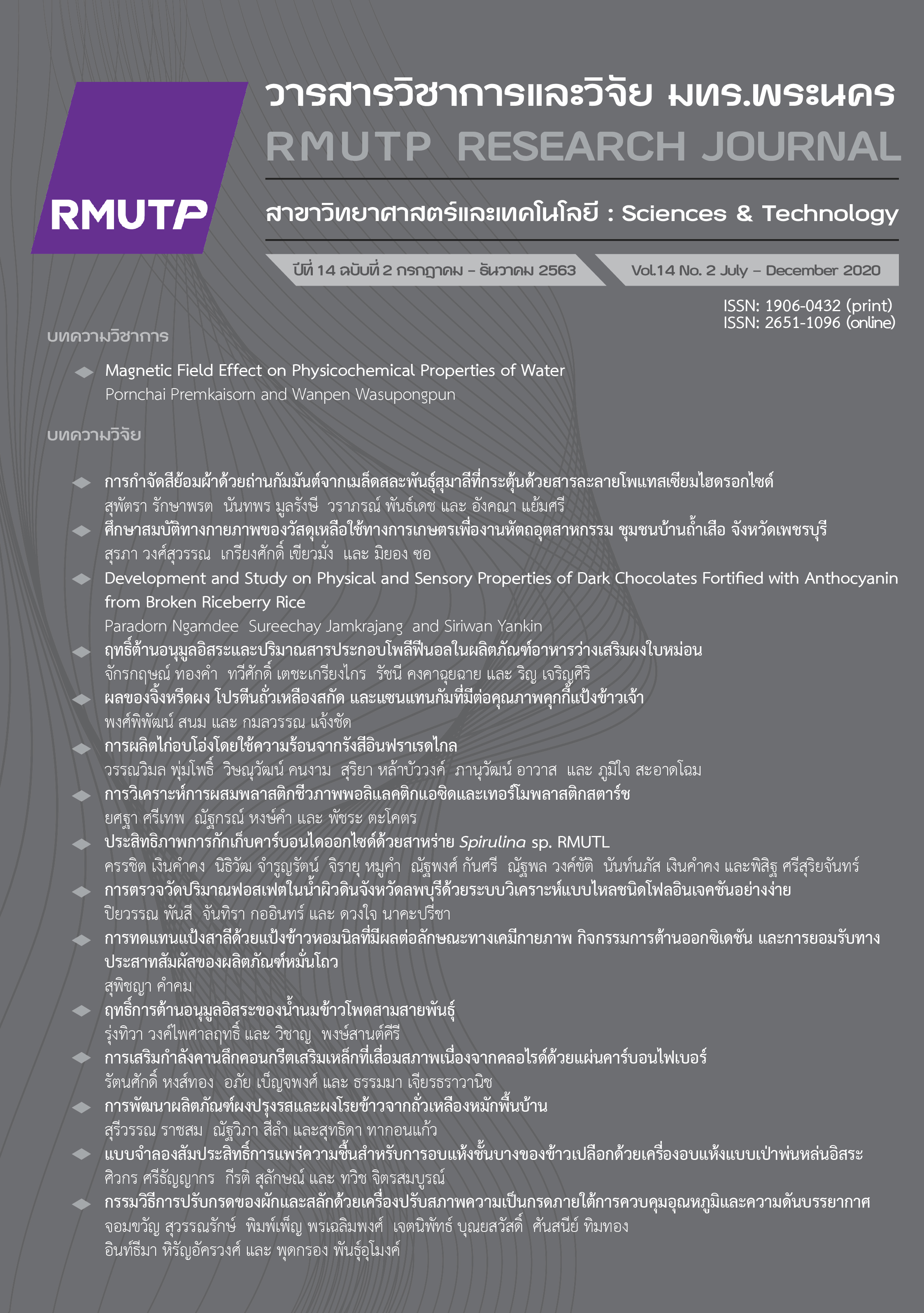Production of Roasted Chicken in Jar Using Heat Transfers from Far-infrared Ray
Main Article Content
Abstract
The objectives of this research were to construct a jar oven for the production of roasted chicken using heat from far-infrared radiation and to find the amount of electricity and specific energy consumption used in the production of roasted chicken. The physical properties in terms of color, softness, cooking yield, and water holding capacity of roasted chicken were also investigated. By using far-infrared radiation at electrical power levels of 1,000, 1,200 and 1,400 watts to roast marinated chicken, which had an initial mass of about 1,650 grams until the mass of the roasted chicken had a lower than 1,220 grams. From the experimental results, it was found that the production of roasted chicken at far-infrared radiation with a high electrical power level requires significantly less electricity and specific energy consumption than that with low electrical power level (P£0.05). Roasted chicken breasts with far-infrared radiation at 1,400 watts had significantly higher lightness (L value) but lower redness (a value) and yellowness (b value) than those of 1,000 watts (P£0.05). However, lightness (L value), yellowness (b value), and redness (a value) of the roasted chicken breast with far-infrared radiation at 1,200 watts were not significantly different from those at 1,000 and 1,400 watts (P>0.05). The shear force and water holding capacity of roasted chicken were significantly increased when the electrical power levels of far-infrared radiation increased (P£0.05). Moreover, the electrical power levels of far-infrared radiation (1,000 1,200 and 1,400 watts) did not significantly affect the cooking yield of roasted chicken (P>0.05).
Article Details
References
Office of Agricultural Economics, Important Agricultural Products Situation and Trends in 2020. Bangkok: Office of Agricultural Economics, 2019.
T. Kanasri, S. Mongmechai, P. Prasertsang and S. Yinde, “Development of direct fired oven a grill chicken using charcoal,” Journal of Science and Technology Mahasarakham University, vol. special, pp. 670-673, 2014.
S. Makmaitree, “Food consumption behavior for safety from toxic substances,” NKRAFA Journal of Science and Technology, vol. 14, no. 1, pp. 118-129, Jan.-Dec. 2018.
S. Thongdaeng and B. Lamlerd, “Thermal image technique and thermal efficiency comparison of fired oven chicken,” Udon Thani Rajabhat University Journal of Science and Technology, vol. 6, no. 2, pp. 67-79, Jul.-Dec. 2018.
P. Sa-adchom and T. Swasdisevi, “Pork slices drying using a combined vacuum and far-infrared radiation technique,” Industrial Technology Lampang Rajabhat University Journal, vol. 7, no. 1, pp. 83-97, Jan. 2014.
N. Boudhrioua, N. Bahloul, I.B. Slimen and N. Kechaou, “Comparison on the total phenol contents and the color of fresh and infrared dried olive leaves,” Industrial Crops and Product, vol. 29, no. 2-3, pp. 412-419, 2009.
M. Vogt, “Infrared drying lowers energy costs and drying times,” Plastics, Additives and Compounding, vol. 9, no. 5, pp. 58-61, 2007.
P. Kongpoopha, U. Tapai and P. Sa-adchom, “Effect of drying temperatures on charcoal briquettes drying using a combined solar energy and far-Infrared radiation dryer, and a far-infrared radiation dryer,” RMUTP Research Journal, vol. 10, no. 1, pp. 77-93, Mar. 2016.
S. Srisongkram, “Effect of stocking density on growth, carcass and meat quality of broilers,” Seminar report, Dept. Animal Sci., Prince of Songkla University, Songkla, Thailand, 2017.
Thai Industrial Standards Institute, Thai Community Product Standard: Roast Chicken (TCPS 1028/2548). Bangkok: Thai Industrial Standards Institute, 2005.
N. Kansaard, A. Khruakaew, P. Saesong and P. Sa-adchom, “Effect of hot air velocity on preserved tomatoes drying using combined conveyor system and hot air,” RMUTP Research Journal, vol. 12, no. 1, pp. 1-13, Jan.-Jun. 2018.
S. Wattanachant, S. Benjakul and D.A. Ledward, “Effect of heat treatment on changes in texture, structure and properties of Thai indigenous chicken muscle,”Food Chemistry, vol. 93, no. 2, pp. 337-348, 2005.
B.A. Showell, J.R. Williams, M. Duvall, J.C. Howe, K.Y. Patterson, J.M. Roseland and J.M. Holden, USDA Table of Cooking Yields for Meat and Poultry. Maryland: U.S. Department of Agriculture, 2012.
M. Zheng, Y.W. Huang, S.O. Nelson, P.G. Bartley and K.W. Gates, “Dielectric properties and thermal conductivity of marinated shrimp and channel catfish,” Journal of Food Science, vol. 63, no. 4, pp. 668-672, 1998.
T. Klathae and P. Jitpat, “Compressive strength and water absorption properties of concrete block containing crushed oyster shell,” RMUTP Research Journal, vol. 13, no. 1, pp. 25-38, Jan.-Jun. 2019.
M. Nachaisin, P. Pumniam, W. Jansopha, N. Ananaur and W. Pharanat, “Specific energy consumption and drying kinetics of far-infrared dried,” Journal of Science & Technology, Ubon Ratchathani University, vol. special, pp. 71-76, Oct. 2016.
U. Teeboonma, T. Suwanakoot and S. Soponronnarit, “Beef drying using infrared radiation,” KKU Engineering Journal, vol. 33, no. 2, pp. 169-180, Mar.-Apr. 2006.
S. Kerdpiboon, “Using of sous-vide process to beef steak ready to cook and beef mussaman curry production,” Research report, Dept. Agro-Industry, King Mongkut's Institute of Technology Ladkrabang, Bangkok, Thailand, 2015.
L. Christensen, P. Ertbjerg, M.D. Aaslyng and M. Christensen, “Effect of prolonged heat treatment from 48°C to 63°C on toughness, cooking loss and color of pork,” Meat Science, vol. 88, no. 2, pp. 280-285, 2011.
P. Sa-adchom, T. Swasdisevi, T. Thomthong, P. Samuttharin and S. soponronnarit, “Drying of ground fish slices using superheated steam,” RMUTP Research Journal, vol. 7, no. 2, pp. 74-86, Mar. 2013.
G. Offer and J. Trinick, “On the mechanism of water holding capacity in meat, the swelling and shrinking of myofibrils,” Meat Science, vol. 8, no. 4, pp. 245–281, 1983.


